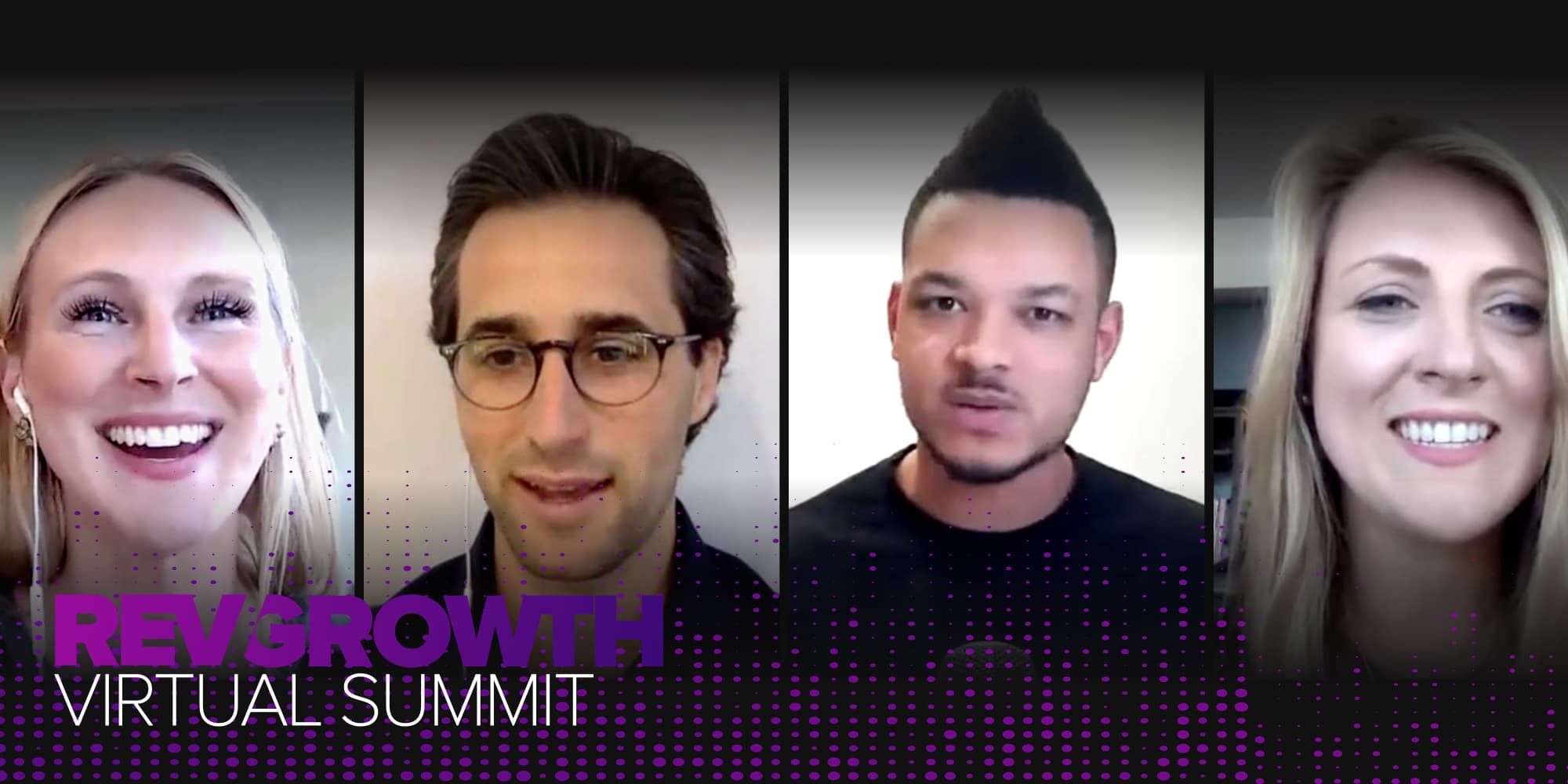Audience engagement has always been top of mind for event marketers.
And when virtual conferences took over the events industry in 2020, event organizers became even more hard-pressed to drive virtual audience engagement and deliver exceptional experiences for our attendees.
As we strategize our event programming in 2021 and beyond, virtual events will continue to play a major role, both on their own and as part of a hybrid event approach.
Event marketers are looking for guidance on how to run virtual events and are eager to learn the secrets to driving attendee engagement.
That’s why our team at Bizzabo surveyed over 700 attendees and analyzed almost 1,000 virtual events to find out what virtual attendees really want from their online experiences.
Read on to dive into our findings from the Virtual Attendee Experience Report and discover solutions and examples for fostering virtual audience engagement when you host your next virtual event.
1. People Are Attending More Virtual Events Than They Did In-Person
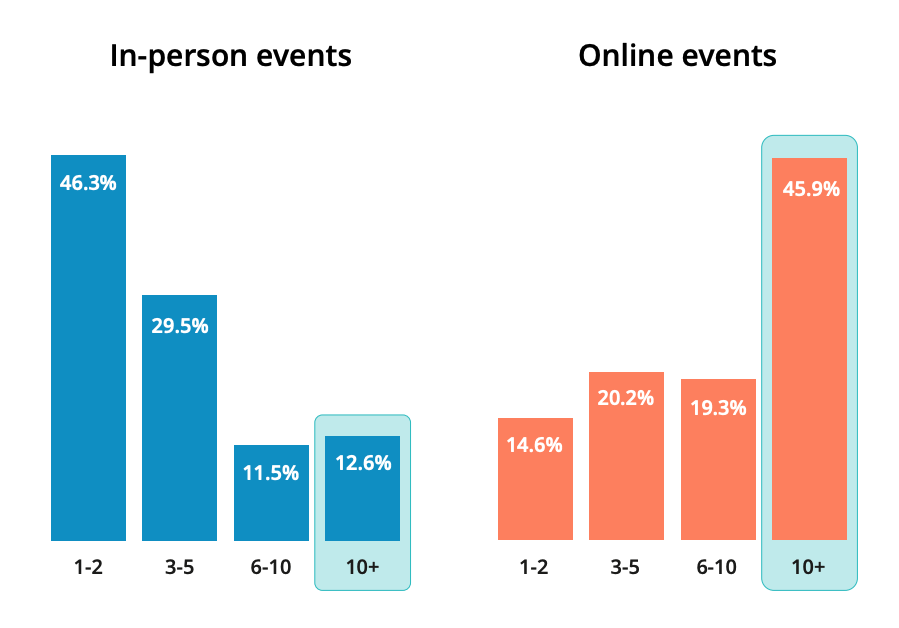
As many organizers have experienced first-hand, virtual events are breaking down the barriers of entry and making it easier than ever for audiences to access our content and attend our events.
By removing obstacles like travel and time zones, we’ve seen a major shift in the number of events that people are able to attend online compared to live experiences.
In-person events require planes, trains, and cars – not to mention a lot of time and coordination. But now you can log into an online event from anywhere – even your couch.
Many online experiences also leverage on-demand capabilities, which allow people all over the world to watch on their own time. Whether they are in a different time zone, or simply have other obligations, on-demand gives our audience the ability and agency to engage with our events when it’s convenient for them.
Having the flexibility to attend online events from anywhere, anytime could be a major catalyst for this spike in virtual event attendance.
And with attendees tuning in to more events than ever, organizers will need to continue to deliver unique, cutting-edge experiences in order to keep virtual audience engagement high.
2. While Virtual Attendees Stay for Less Time, They Attend More Virtual Event Sessions Than In-Person
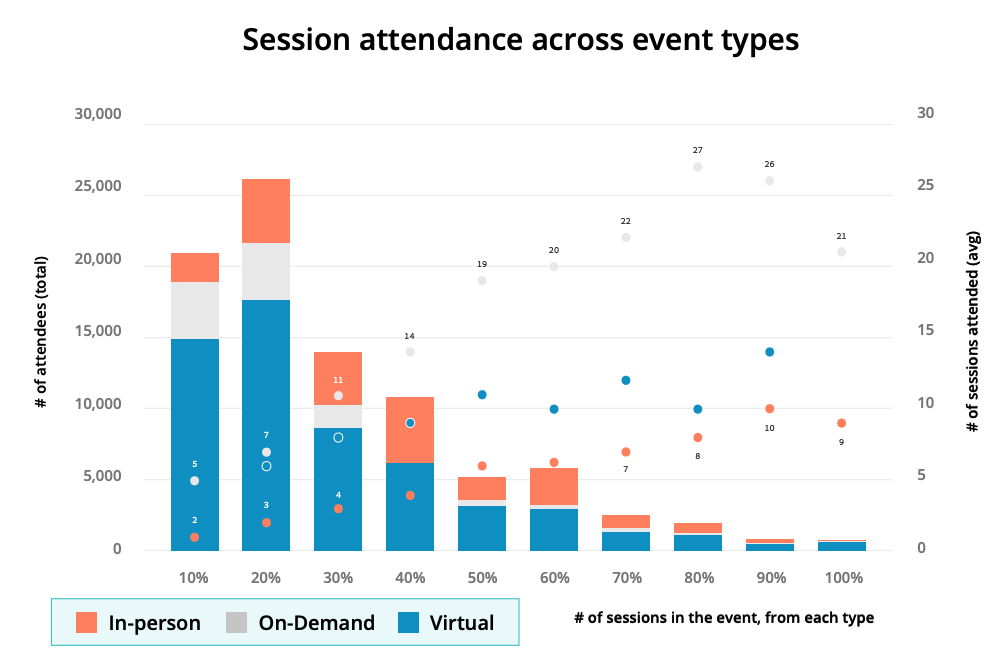
One of the most common ways to measure virtual audience engagement is to see, on average, how many sessions people attend and how long they are engaged in each of those sessions.
29% of virtual attendees only view 20% of the average session, followed by 26% only watching 10% of the average session.
While our data shows that virtual attendees are not be staying for as long, they are tuning in to a higher number of sessions than they did at in-person events.
This might suggest that shorter, more digestible content would resonate with your audience (and would result in higher attendee engagement).
3. Attendees Are More Focused on Learning, Less on Networking at Virtual Events
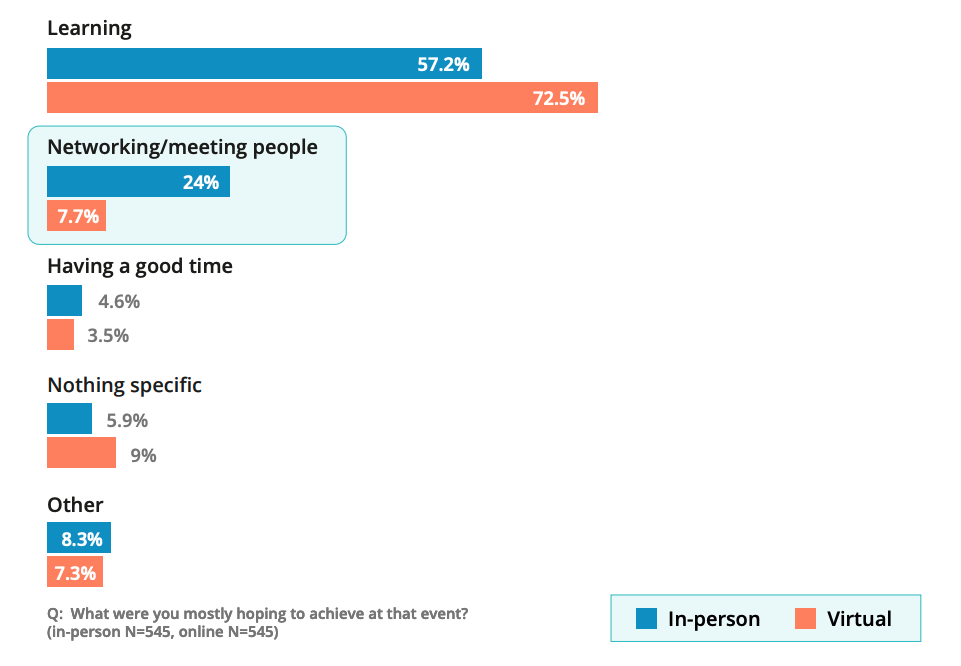
This finding should come as a welcome surprise for event marketers.
While a lot of us might assume that attendees are looking for the same networking opportunities they had at in-person events, the data shows that online attendees are actually much more interested in learning and growing their skills at virtual events.
In fact, almost three-fourths of virtual attendees said learning was their main goal, compared to less than 10% who specified networking as their top priority.
And compared to in-person events, virtual attendees were three times less likely to choose networking as their main goal. This is a sigh of relief for event organizers who may have been concerned about their events falling short in the networking department. While there is still much we can do to promote networking and create opportunities for our attendees to connect, steering into the learning aspect will serve our audiences well. We’ve noticed an increasing trend of virtual event organizers leaning on intimate, workshop-style sessions to drive attendee engagement with content while also providing an opportunity for the power networkers out there to connect.
In the online space, content is the best way to foster audience engagement. If you create impactful content and deliver it in a unique and effective way, your virtual attendees will be much more engaged at your event.
4. Almost Half of Virtual Attendees Say Learning Was Their Main Priority
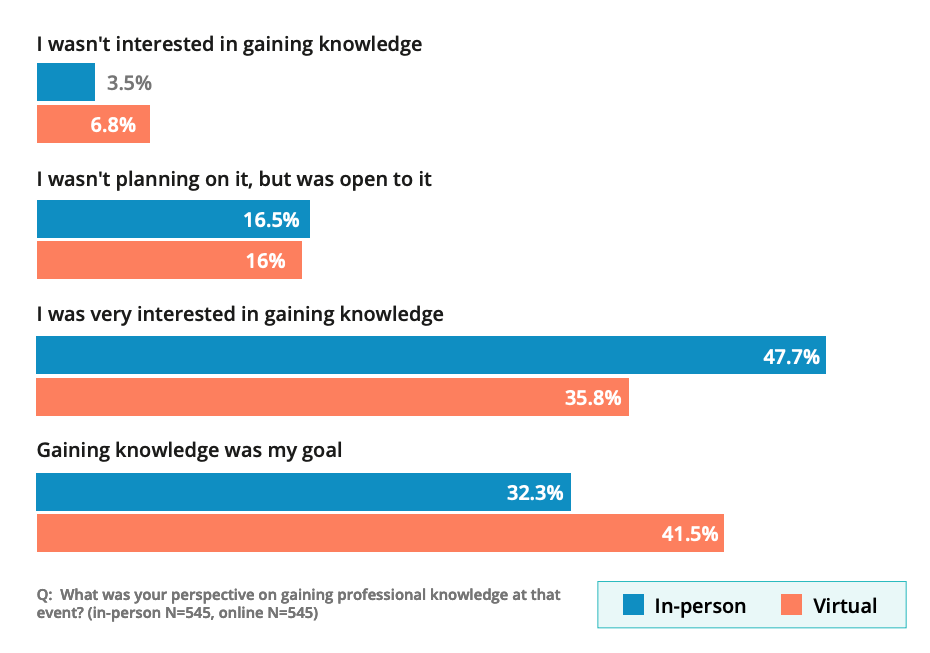
Virtual attendees have shown that they are hungry to learn and gain knowledge at online events, especially compared to in-person.
But just how important is learning? Well, it turns out that attendees are almost 29% more likely to set learning as a main goal online, compared to live events.
How can we as event organizers help our attendees reach their goal of gaining knowledge at our online events? For one, we can secure great speakers who will engage our audience and bring unique perspectives to the content.
We can also leverage how the virtual space lets us promote and amplify our content. Virtual events platforms are a great solution for attendees because they can consume content quickly and at their own pace.
Many virtual events also offer more concurrent sessions and more robust tracks than physical events, which are limited by the size of the space and the number of rooms available.
5. Attendees Are Learning Less Than They Hoped to at Virtual Events
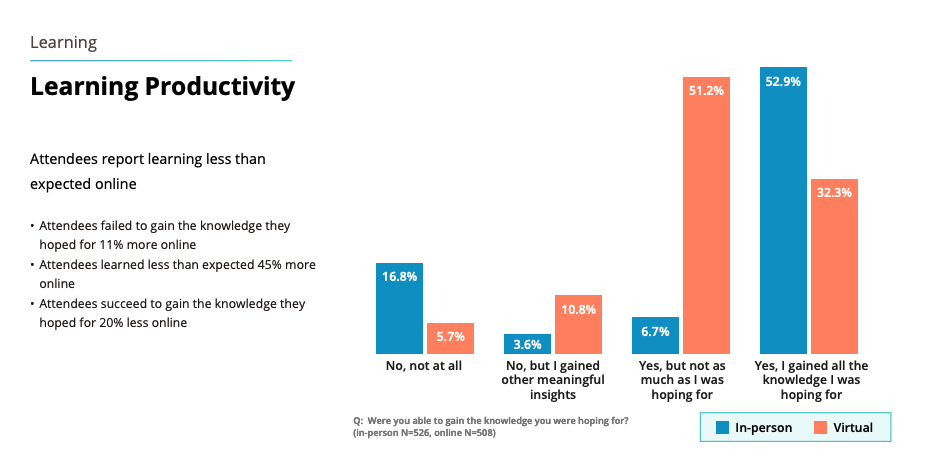
Despite virtual attendees choosing learning as their main goal at online events, most virtual attendees say organizers are still missing the mark.
In fact, virtual attendees were more than seven times as likely to say they did not gain as much knowledge as they were hoping for than in-person attendees.
Coupled with the fact that people are eager to learn, it’s a shocking discovery that they aren’t getting the value that they hope for in virtual events. Our virtual attendees have expressed that they want to learn and engage deeply with our content, but they are left wanting more from their online experiences.
As event marketers, this stat makes a strong case for diving even deeper into the topics we’re programming our events around. Often, it can take some time for the conversation to start flowing, and therefore, it can feel like the session is over just when it gets to the good part.
So how can we help our attendees get the most out of their online experiences?
Don’t hold back when it comes to your virtual event content. If you want to drive virtual audience engagement, listen to the feedback attendees are giving and use these findings to help you iterate and improve your next event so that hopefully you can create even more impact for your attendees.
6. Networking Conversations Flow Less Naturally at Virtual Events
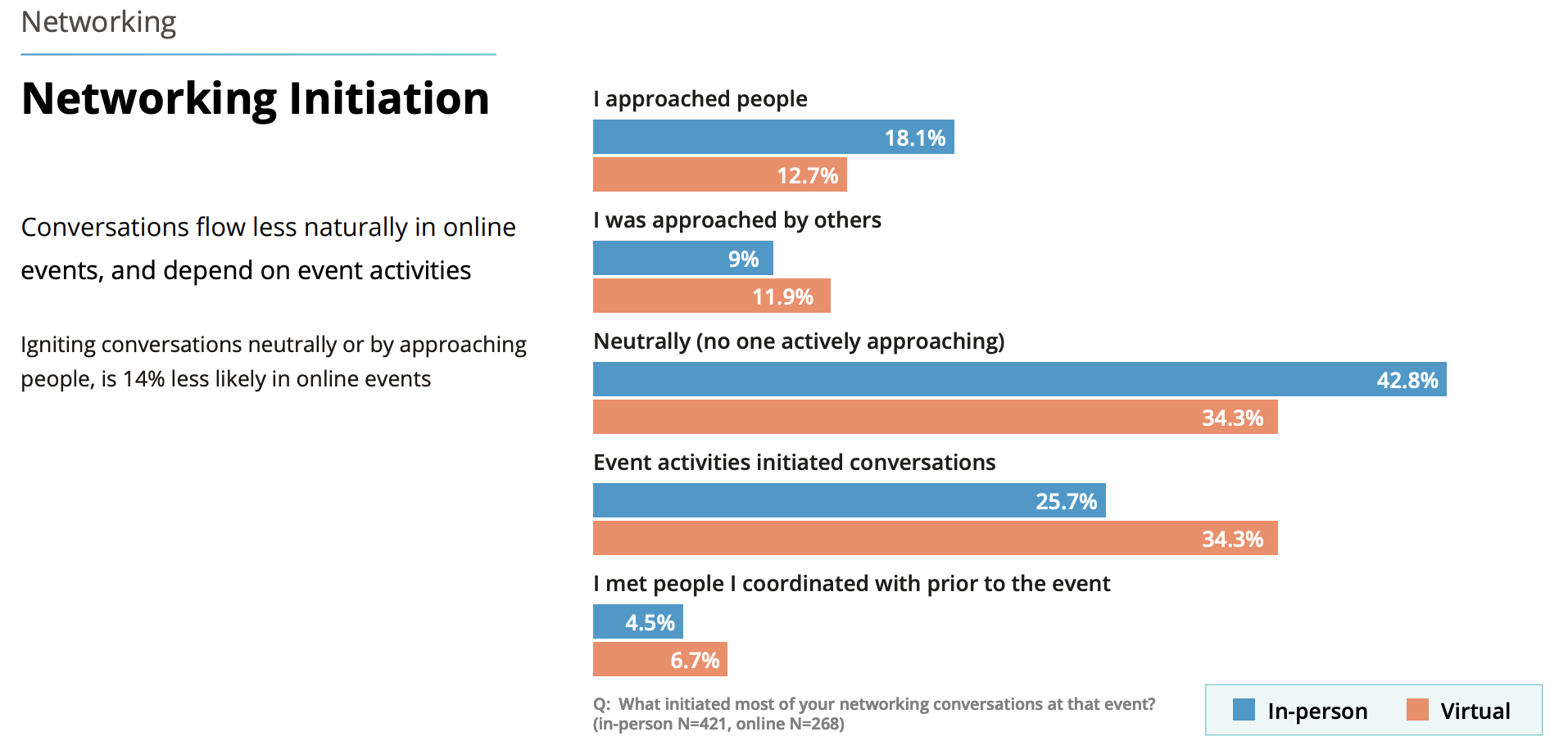
In a physical venue, there are natural moments that spark conversations among attendees. Grabbing coffee in the morning, sitting down for lunch, and bumping into peers between sessions are all opportunities for interaction that virtual events don’t really provide.
That could be why over 40% of attendees report that networking happened naturally at in-person events, yet online, people are less likely to enter into conversations neutrally or by approaching others.
In fact, virtual networking is actually 23% less likely to occur naturally or by approaching others.
While the report does show us that attendees are more interested in learning than networking, you may still want to promote networking at your virtual event to cover your bases and be as inclusive as possible.
And in that case, this particular chart is a great tool to understand how exactly attendees are networking at virtual events.
From this data, we can see that event activities are more likely to promote networking online. Many virtual events actively facilitate networking at events, which if done well, seems to work for attendees.
However, you can also use tools like social media or leverage your online community to encourage attendees to get to know each other before the event even starts.
This way, people can start networking and having those conversations beforehand, which will drive virtual attendee engagement during and even after the event.
7. Virtual Attendees Are Having Less Fun Than They Did at In-Person Events
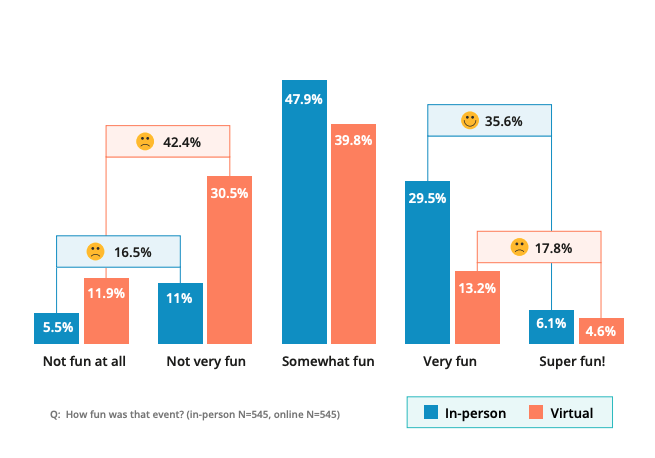
Attendees are more than twice as likely to rate virtual events as “not fun at all” compared to in-person events.
This is a pretty significant statistic and reveals that there is a real opportunity to improve virtual attendee engagement.
While virtual experiences may not seem as well-positioned to promote fun, there are a lot of creative ideas that event organizers can bring to their online event strategy to drive value.
For example, adding interactive elements such as live polls or Q&A functionality is a great way to draw in your audience and bring the content to life. You can also create memorable moments by breaking up your sessions with entertainment.
There are endless options to choose from and some may be a better fit for your particular audience. DJs, musicians, magicians, comedians…there’s certainly no lack of entertainers and performers out there that you can leverage to make sure your attendees are having fun. Plus, it’s a great way to support local artists and talent.
Final Thoughts
Event marketers are feeling the pressure to drive virtual audience engagement, and in order to be successful, it helps to have an understanding of what exactly our attendees want out of their online experiences. Here’s a quick recap of how attendees feel about virtual events:
- People are attending more online events than they used to attend on-site.
- Virtual attendees attend more sessions than their in-person counterparts, but don’t stay for as long.
- Attendees are more interested in learning, gaining knowledge, and growing their skills at virtual events than they are at physical events.
- Virtual events leave attendees wanting more information and a deeper understanding of the content.
- Virtual attendees are less likely to be focused on networking at online events.
- Networking at virtual events is usually prompted by event activities.
- Attendees do not consider virtual events as fun as in-person events.
If you want to learn even more about virtual attendee engagement – including the six virtual attendee personas we uncovered from our research, download the Virtual Attendee Experience Report.
Rachel is the Content Marketing Associate at Bizzabo where she leverages her 3+ years as an event planner and B2B marketer to provide helpful resources and insight to event and marketing professionals.








